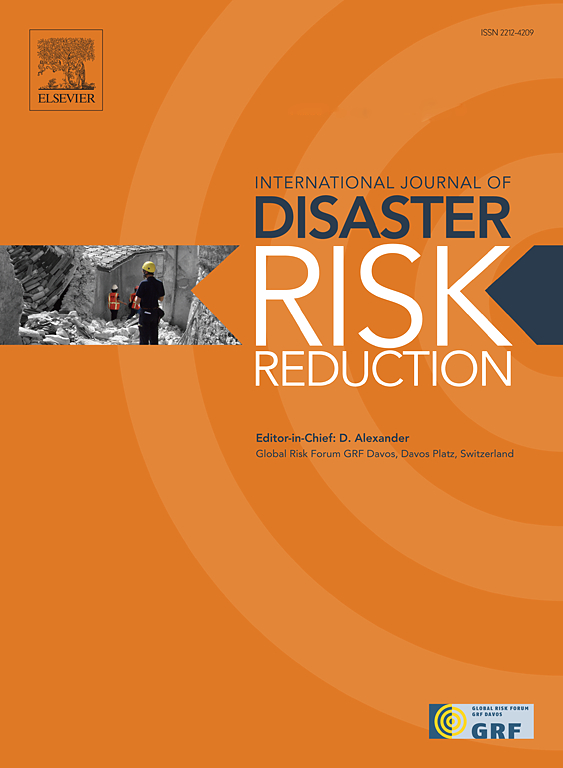Weather and climate extremes in Nigeria: Modeling the perceived impact of spatial planning and community practices on windstorm and flood exposure using PLS-SEM and correlogram
IF 4.2
1区 地球科学
Q1 GEOSCIENCES, MULTIDISCIPLINARY
International journal of disaster risk reduction
Pub Date : 2025-05-09
DOI:10.1016/j.ijdrr.2025.105554
引用次数: 0
Abstract
The study examines the interplay between spatial planning, community disaster practices, and the impacts of weather and climate-related extreme events (WCEE) in urban neighborhoods. Using a multi-method approach based on Sankey diagrams, Partial Least Squares Structural Equation Modeling (PLS-SEM), and R, we analyze survey data from 259 respondents across nine frequently affected neighborhoods. The Sankey diagram demonstrates the flow and patterns of the strong connection between WCEE, climate change, and local human factors. PLS-SEM models the direct effects of perceived local human factors within spatial planning and community risk practices on WCEE exposure and impact. Using 19 items within four latent constructs based on a reflective-formative measurement model, the analysis reveals that respondents view these factors as significantly affecting disaster outcomes. Additionally, R's correlogram identifies specific neighborhood vulnerabilities contributing to increased WCEE exposure and impact. The findings underscore the need for achieving city-wide disaster risk reduction strategies that integrate spatial planning, policy development, and inclusive community engagement.
尼日利亚的极端天气和气候:利用PLS-SEM和相关图模拟空间规划和社区实践对风暴和洪水暴露的感知影响
该研究考察了城市社区空间规划、社区灾害实践以及天气和气候相关极端事件(WCEE)影响之间的相互作用。采用基于Sankey图、偏最小二乘结构方程模型(PLS-SEM)和R的多方法方法,我们分析了来自9个频繁受影响社区的259名受访者的调查数据。Sankey图展示了WCEE、气候变化和当地人为因素之间紧密联系的流程和模式。PLS-SEM模拟了空间规划和社区风险实践中感知到的当地人为因素对WCEE暴露和影响的直接影响。利用基于反思-形成性测量模型的4个潜在构式中的19个项目,分析显示被调查者认为这些因素对灾害结果有显著影响。此外,R的相关图确定了导致WCEE暴露和影响增加的特定社区脆弱性。研究结果强调,有必要制定全市范围的减灾战略,将空间规划、政策制定和包容性社区参与结合起来。
本文章由计算机程序翻译,如有差异,请以英文原文为准。
求助全文
约1分钟内获得全文
求助全文
来源期刊

International journal of disaster risk reduction
GEOSCIENCES, MULTIDISCIPLINARYMETEOROLOGY-METEOROLOGY & ATMOSPHERIC SCIENCES
CiteScore
8.70
自引率
18.00%
发文量
688
审稿时长
79 days
期刊介绍:
The International Journal of Disaster Risk Reduction (IJDRR) is the journal for researchers, policymakers and practitioners across diverse disciplines: earth sciences and their implications; environmental sciences; engineering; urban studies; geography; and the social sciences. IJDRR publishes fundamental and applied research, critical reviews, policy papers and case studies with a particular focus on multi-disciplinary research that aims to reduce the impact of natural, technological, social and intentional disasters. IJDRR stimulates exchange of ideas and knowledge transfer on disaster research, mitigation, adaptation, prevention and risk reduction at all geographical scales: local, national and international.
Key topics:-
-multifaceted disaster and cascading disasters
-the development of disaster risk reduction strategies and techniques
-discussion and development of effective warning and educational systems for risk management at all levels
-disasters associated with climate change
-vulnerability analysis and vulnerability trends
-emerging risks
-resilience against disasters.
The journal particularly encourages papers that approach risk from a multi-disciplinary perspective.
 求助内容:
求助内容: 应助结果提醒方式:
应助结果提醒方式:


